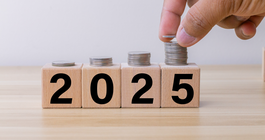
July 12, 2017
Stacking coins side by side, it's obvious that the dime is quite a bit smaller than the nickel before it -- even the penny.
What's up with that?
Curious, we sought an answer from Karie Diehorn, chief curator of National Independence Historical Park, which includes the Second Bank of the United States and all the mint history that comes along with it.
Why is the dime smaller than the other U.S. coins we use? It's sort of the odd one out in the hierarchy since they otherwise get increasingly bigger in size in relation to their worth.
The size of today's U.S. coins dates back to an earlier era when that size was determined by how much precious metal (i.e., silver) or base metal (copper, nickel) the coins contained. Historically, a dime was comprised of 10 percent of the silver present in a silver dollar. There was even a half-dime made up of 5 percent of the silver present in a silver dollar; that coin was physically too small to be practical and it was discontinued in the 19th century. Since 1964, no U.S. coins have contained any silver -- their silver color is actually nickel plated over copper.
However, regardless of their lack of silver content, U.S. coins have retained their proportionate historic sizes.
Were the First Bank's banknotes the very first national currency we used? Were those similar to dollar bills?
Actually, the Bank of the U.S. paper wasn't official currency, even though it did provide a level of uniformity nationwide since it was widely accepted and could be used to pay federal taxes. There was no official national currency until the Civil War. Prior to that, individual banks printed their own "notes of credit," or promises to pay, which circulated as currency. This wide variety is part of the reason why the late 18th and 19th centuries were a roller coaster of inflation and deflation.
How did people store their money during those days? Did people keep wallets? I don't believe they had pockets yet...
In the 18th century, people did indeed carry wallets. And, clothing in the western world has actually included pockets since the Middle Ages. Men's pockets were in their waistcoats and coats; women's pockets were two pouches on a string that tied around the waist under the skirt, which was accessible through slits in the sides of the skirt.
Any idea if our currency kept any design inspiration from the original banknotes?
I've never done a focused study, but my immediate answer is "No." The symbolism on today's currency -- e.g., the pyramid and eye on the back of the one-dollar bill -- is frequently derivative of late-18th-century iconography, but colonial currency (printed by each of the thirteen colonial governments) and federal era notes of credit (printed by individual banks) generally didn't include this type of imagery. Rather, natural motifs and line designs are common on colonial currency, while federal era notes of credit feature mostly text and sometimes the eagle.
What happened to the British currency kept after the Revolution? Did colonials-turned-Americans manage to exchange their money for the new currency very easily?
After the Revolution, Americans were still using all kinds of existing currency and coins, both English and European, because in the decades immediately following the war it was the only money available. There was never a universal exchange date. American coins continued to be supplemented by English and European money well into the 19th century and weren't banned until 1857. Actually, non-American money was probably preferred by many people in the late-18th and early-19th centuries because its value was well-established.
FYI, the first U.S. Mint started coinage in 1792. The U.S. Treasury began printing currency in the early 1860s.
Philadelphia has both the First Bank of the United States and the Second. Not sure if this gets asked often, but why did they feel the need to build a new building after the first one failed?
The first Bank of the U.S. didn't "fail." Rather, its 20-year charter, spanning 1791 to 1811, expired. In 1816, the Second Bank of the U.S. was chartered for 20 years. President Andrew Jackson vetoed the Bank's charter in 1832, so the Bank never made it through its charter period -- and a new building was commissioned. The Second Bank of the U.S. was housed in a new building because the first building had been sold to Philadelphia merchant Stephen Girard.
What are some facts about those two banks that usually surprise people?
Architecturally, both banks have interesting features. The First Bank building's 3rd Street side features a marble portico, the columned section with steps. It was the first on a public building in America. It also features a carving of the American eagle in the portico's triangular pediment -- the first architectural representation of the American bald eagle. The Second Bank building has an unusual theft-deterrent aspect: inside the building's foundation walls there are randomly spaced iron balls about the size of an apple. Any hand-driven drill bit striking one of these balls would simply spin, rather than penetrate the foundation walls.